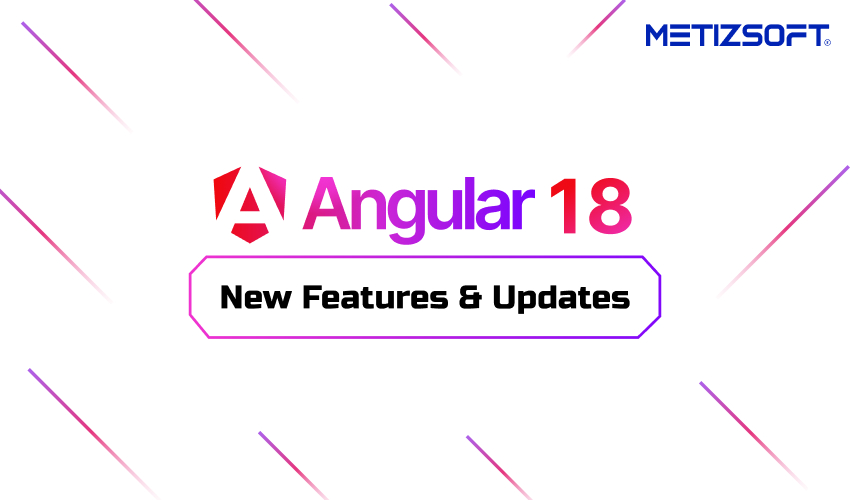
Following the release of Angular 17 in November 2023, expectations were high for a new version. The latest version, Angular 18, is here and ready for use. Therefore, it would be interesting to see what it brings to the development landscape.
Angular has consistently modernized to meet developers’ demands and overcome challenges. In addition, presenting new features and improvements with each version.
So, let’s dive in and explore what the newest version of Angular has kept in its bucket for the technological world.
Table of Contents
Introducing Angular 18
The awaited time has come! Google’s widely used web development framework, Angular, has revealed its latest version, Angular 18, on May 22, 2024. This new version includes an array of new features and updates for developers to incorporate into their projects.
Angular 18 is set to deliver better performance and developer productivity. The smooth approach will help construct robust and flexible applications.
What’s New in Angular 18? Top Features & Updates
Angular v18 introduces a new reactivity model and significant improvements in state management. Plus, you will get to use data handling and application logic flow precisely. This latest version significantly improves on the initial release, which required developers to write extensive boilerplate code.
Zoneless Change Detection: Over time, Angular has been working on a new approach to remove the need for zone.js. The latest version introduced the first experimental features of a zoneless Angular.
Developers can now try out Angular’s new zoneless support by adding `provideExperimentalZonelessChangeDetection` to their application’s startup.

Post-provider addition, consider removing zone.js from your polyfills in angular.json.
The best way to use Zoneless is with Signals in Components.

Default Coalescing: Starting in version 18, Angular now uses the same scheduler for apps without zones and apps using zone.js with coalescing enabled. In Angular 18, zone coalescing is now available by default to reduce the number of change detection cycles in new zone.js apps.
However, this change is only helpful for new applications. That’s because it may cause bugs in apps that rely on the previous change detection behavior. Coalescing helps to reduce unnecessary change detection cycles. It significantly improves performance for some applications that are updated to the latest version of Angular.
To enable event coalescing for current projects, you must customize your NgZone provider in the bootstrapApplication function.

This configuration allows for event coalescing, which helps enhance performance by reducing redundant change detection cycles.
Route Redicrects with Functions: In Angular 18, functions can now handle redirects by changing the static strings in the “redirectTo” property of the Route object. This improvement provides more flexibility in routing. Consequently, the function can parse an object with URL parameters and then return a string or the UrlTree, improving the efficiency and navigation of web applications.

TypeScript 4.7 Support: Angular 18 now supports TypeScript 4.7, bringing in new features and improvements for developers. These include template literal types, improved support for readonly, and new Import Types. Specifically, these changes aim to improve template typing. Additionally, it will provide a better understanding of the readonly keyword. Ultimately, this enhances the flexibility of the code.
Latest ng-template API: The new ng-template API eliminates the need to create distinct templates for specific selectors. It enhances the API’s reusability.
Debugging Tools Upgraded: Angular 18 incorporates new tools to enhance application debugging. Specifically, these tools provide comprehensive information about the application’s state. It facilitates debugging with source maps and visualizes component trees. Moreover, it manages data bindings and conducts performance profiling.
Updated Official Documentation Website: Angular developers now have a new official documentation website at Angular.dev. In fact, all requests to angular.io will now automatically redirect to angular.dev. The new website offers a modern experience with a hands-on tutorial. A live playground with examples and improved search using Algolia. Additionally, it features redesigned guides and more straightforward navigation.
Hydration Support in CDK and Material: The Angular Material, CDK components, as well as primitives, have been updated to be fully hydration compatible. This ensures consistent rendering behavior across different environments.
Unified Control State Change Events: In the v18 release of Angular, new functionality has been introduced to forms by adding the “events” property in the FormControl, FormGroup, and FormArray classes. This means developers can now to subscribe to a stream of events for each form control. As a result, it facilitates meticulous tracking of changes in value, touch state, pristine status, and control status. Use the following method to enable this feature:

Angular 18 Updates Stable Segments
Materials: Several months ago, the Angular team introduced experimental support for Material 3. Now, the current Angular version is stable after integrating developers’ feedback and refining Material 3 components. Additionally, along with this update, Angular 18 features include a revamped material.angular.io with new Material 3 themes and updated documentation.
Deferrable Views: Introducing deferrable views has helped developers improve their apps’ Core Web Vitals. Now, Angular’s latest version has stabilized deferrable views, allowing developers to use them in their applications and libraries. In its release, Angular mentioned a company that reported a 50% reduction in the bundle size of one of its apps when using `@defer.`
Built-in Control Flow: Alongside deferrable views, Angular 18 introduced a new built-in control flow with enhanced performance in v17. After significant adoption and addressing community feedback, the Angular team announced that this API is stable.
Standalone Components: In Angular version 18, developers can now create standalone components without relying on Angular modules. This change simplifies the project structure, promotes code reusability, and optimizes tree-shaking for smaller bundle sizes and faster load times.
ESM (ECMAScript Module) Support: The update adds ECMAScript Modules (ESM) support to Angular, aligning it with modern JavaScript standards. Consequently, this support facilitates integrating popular libraries and tools, improving code splitting and loading. Despite potentially increasing requests, using ESM speeds up initial load times while ensuring a smooth user experience.
Component-Level State Management: The update simplifies state management at the component level for small to medium applications. Consequently, it makes it easier to understand state changes and component interactions. It was previously managed at the service level or through global state libraries like NgRx.
Angular 18 Features Improvements
Enhanced Performance with Ivy: Angular 18 has introduced performance enhancements through the Ivy compiler optimization. As a result, it results in quicker start times, improved performance, and smaller bundle sizes.
Improved Forms API: The update to Forms A streamlines the process of generating and validating forms. This means it offers enhanced flexibility and incorporates more advanced validation features.
Revamped AOT Compilation: In Angular 18, the Ahead-of-Time (AOT) compilation process facilitates faster processing of large-scale applications and improved interoperability with third-party APIs. Consequently, this optimization reduces the reliance on just-in-time compilation.
Enhanced Reactivity Model: Angular 18 streamlines state management and data flow by introducing its new reactivity model. This user-friendly model diminishes the need for excessive code and enhances change detection, improving overall system performance. These advancements simplify the handling of intricate state interactions.
Build Performance: The new release enhances build performance and optimizes build times, especially for large projects. Improvements in the Angular CLI, better caching mechanisms, and incremental compilation contribute to faster and more efficient development cycles. Overall, these advancements lead to smoother development.
Server-Side Rendering: SSR in Angular v18 is optimized for better performance and integration. Specifically, enhancements include improved pre-rendering, faster server-side hydration, and better support for Angular Universal. These improvements help reduce the Time to Interactive (TTI) user experience, particularly on slower networks.
Improved Internationalization (i18) Support: With new APIs and tooling enhancements, Angular 18 improves internationalization support. Moreover, it simplifies application localization scenarios, which benefits developers targeting a global audience.
Accessibility: The latest version places a strong emphasis on accessibility through the introduction of new directives and components. That means it aims to enhance compliance with accessibility standards. Ultimately, these enhancements facilitate the development of all-encompassing web applications, providing developers with an improved foundation for inclusivity.
Additional Angular 18 Features
The Angular project has introduced several exciting bonus features and new updates, as outlined by the recent commits.
- Angular 18 introduces the `@angular/localize` package, simplifying Internationalization and localization by making extracting and translating application strings easier.
- Angular 18 introduces new lifecycle hooks for router guards, improving route activation and deactivation management.
- Error messages in Angular 18 are more descriptive and actionable, aiding developers in quickly identifying and resolving issues.
- The compiler requires TypeScript version 5.4 or newer. No support for older versions.
- Host binding updates for OnPush views at the application root require manual dirty marking. The ComponentFixture.autoDetect won’t refresh host views for OnPush components unless marked dirty.
- Event delegation libraries can hold and later replay events when the application is ready.
- Removed RESOURCE_CACHE_PROVIDER APIs from platform-browser-dynamic.
- The platformDynamicServer has been deprecated and removed. Please use platformServer with the @angular/compiler import instead.
- The ServerTransferStateModule has been removed as it is deprecated; TransferState now functions without it.
- Angular package format FEM2015 has been removed, and ES2020 support has been replaced with ES2022.
- The deprecated XhrFactory export from @angular/common/http has been removed; use the one from @angular/common.
Ways to Install Angular 18
When installing Angular 18, it is recommended that you utilize the npm (Node Package Manager). It cntains a collection of Angular tools essential for the installation process.
Execute the below command in the CLI.
npm install –global @angular/cli@next
By running this command, you can effortlessly install the updated version of Angular CLI on your system.
Conclusion
The newest version of Angular provides powerful tools and features tailored to modern web development requirements. The robust web application framework has taken a significant step forward with its updated features. The latest version of Angular is ready with key components and updates to meet the challenges of modern web application development.
As a leading Angular development agency, we embrace the improvements and are ready to utilize them in our upcoming projects. If you seek end-to-end assistance in your project with the latest Angular 18, hire Angular developers today!
AboutChetan Sheladiya
Related Posts
How to Choose the Right Colors for your website design in 2018?
Undoubtedly, Color is one of the major factors that affect visual and non-verbal communication. It communicates with your...
How To Get Started With Accelerated Mobile Pages (AMP)?
May you have heard about ‘AMP’ right? It has been thrown around on the internet lately. Recently, on 24th February 2016,...

